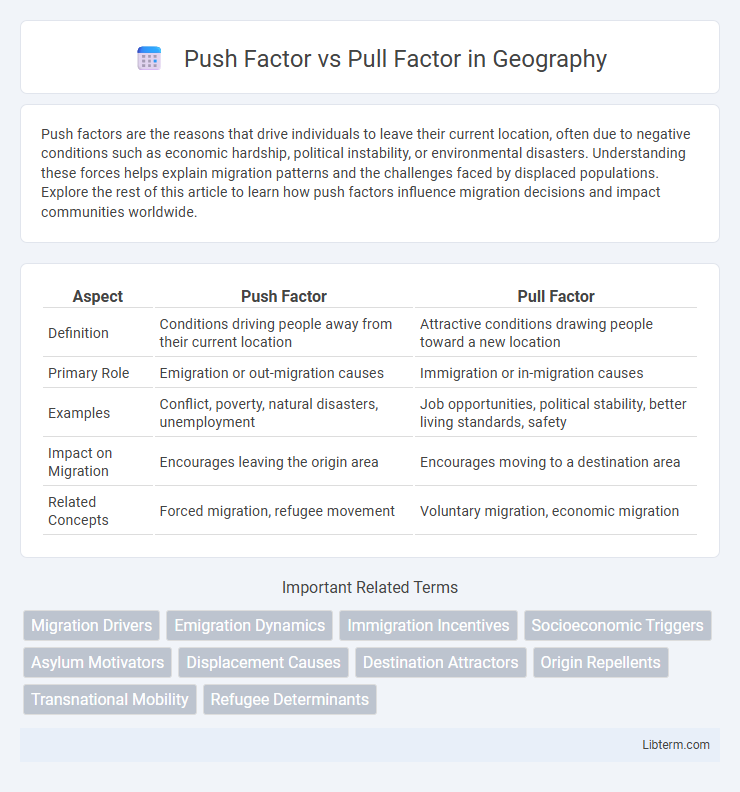Push factors are the reasons that drive individuals to leave their current location, often due to negative conditions such as economic hardship, political instability, or environmental disasters. Understanding these forces helps explain migration patterns and the challenges faced by displaced populations. Explore the rest of this article to learn how push factors influence migration decisions and impact communities worldwide.
Table of Comparison
| Aspect | Push Factor | Pull Factor |
|---|---|---|
| Definition | Conditions driving people away from their current location | Attractive conditions drawing people toward a new location |
| Primary Role | Emigration or out-migration causes | Immigration or in-migration causes |
| Examples | Conflict, poverty, natural disasters, unemployment | Job opportunities, political stability, better living standards, safety |
| Impact on Migration | Encourages leaving the origin area | Encourages moving to a destination area |
| Related Concepts | Forced migration, refugee movement | Voluntary migration, economic migration |
Understanding Push and Pull Factors
Push factors refer to negative conditions or circumstances that drive individuals to leave their current location, such as unemployment, political instability, or natural disasters. Pull factors, on the other hand, are positive attributes of a destination that attract migrants, including better job opportunities, political stability, and improved living standards. Understanding push and pull factors is essential for analyzing migration patterns and the socio-economic motivations behind population movements.
Key Differences Between Push and Pull Factors
Push factors are negative conditions or circumstances, such as unemployment, political instability, or natural disasters, that drive individuals to leave their current location. Pull factors refer to positive attributes like job opportunities, better living standards, and political stability that attract people to a new area. The key difference lies in push factors motivating departure through distress, while pull factors encourage relocation through attraction.
Common Push Factors in Migration
Common push factors in migration include economic hardship, political instability, and environmental disasters, which compel individuals to leave their home countries. High unemployment rates, lack of access to education, and poor living conditions also significantly contribute to the decision to migrate. These adverse circumstances create strong pressures that drive populations to seek better opportunities elsewhere.
Typical Pull Factors Attracting Migrants
Typical pull factors attracting migrants include better economic opportunities, access to higher-quality education, and improved healthcare systems. Stable political environments and safe living conditions also draw individuals seeking security and personal freedom. Furthermore, family reunification and the promise of social services enhance the appeal of destination countries.
Economic Influences: Push vs Pull
Economic push factors include unemployment, low wages, and lack of job opportunities that compel individuals to leave their home country. Contrastingly, economic pull factors encompass higher salaries, better employment prospects, and improved living standards that attract migrants to a new destination. Understanding these economic influences is crucial for analyzing migration patterns and labor market dynamics globally.
Social and Political Push and Pull Factors
Social push factors include discrimination, lack of social services, and poor community support that compel individuals to leave their home countries. Political push factors involve persecution, conflict, and oppressive regimes forcing people to seek safety elsewhere. Conversely, social pull factors attract migrants through promises of better education, healthcare, and inclusive communities, while political pull factors highlight stable governments, protection of human rights, and political freedom as primary motivators for migration.
Environmental Push and Pull Forces
Environmental push factors include natural disasters, such as floods, droughts, and hurricanes, that force populations to leave their homes due to unsafe living conditions or resource scarcity. Environmental pull factors attract migrants to areas with favorable climates, fertile land, and abundant water resources that support agriculture and sustainable living. Both push and pull forces significantly influence migration patterns by shaping the environmental desirability or hazard of different regions.
Historical Examples of Push and Pull Factors
The Great Migration in the United States during the early 20th century exemplifies push factors such as racial segregation and limited economic opportunities in the South, while pull factors included industrial jobs and better living conditions in Northern cities. Similarly, the Irish Potato Famine in the mid-19th century acted as a major push factor driving mass migration due to starvation and poverty, with the United States serving as a pull factor offering prospects for land ownership and employment. These historical instances highlight how socioeconomic hardships and environmental crises drive emigration, whereas employment prospects and political stability attract immigration.
The Impact of Push and Pull Factors on Societies
Push factors such as economic hardship, political instability, and environmental disasters drive individuals to leave their home countries, leading to depopulation and labor shortages in affected regions. Pull factors like better job opportunities, political stability, and higher living standards attract migrants to new areas, fostering economic growth and cultural diversity. The interplay of push and pull factors reshapes societal structures, influencing urbanization patterns, social cohesion, and resource allocation.
Addressing Push and Pull Factors: Policy Implications
Addressing push and pull factors requires targeted policies that reduce adverse conditions driving emigration, such as poverty, conflict, and lack of opportunities, while enhancing attractiveness factors like economic growth, political stability, and social services. Migration management strategies should integrate development aid, conflict resolution, and labor market reforms in origin countries alongside effective immigration policies, legal pathways, and integration programs in destination countries. Coordinated international cooperation and data-driven approaches optimize resource allocation and create sustainable migration frameworks balancing human mobility and security concerns.
Push Factor Infographic

 libterm.com
libterm.com